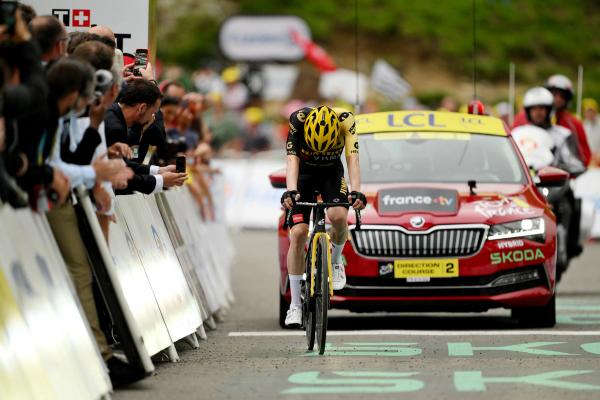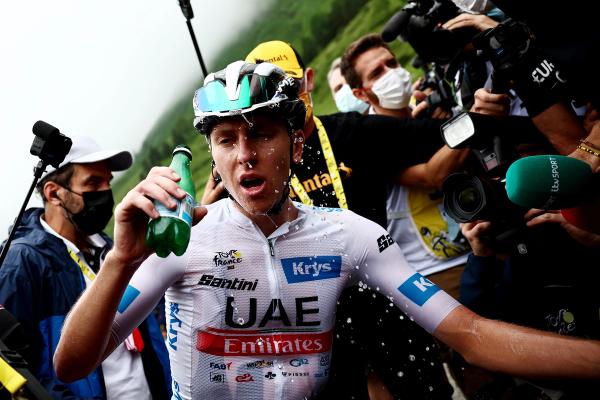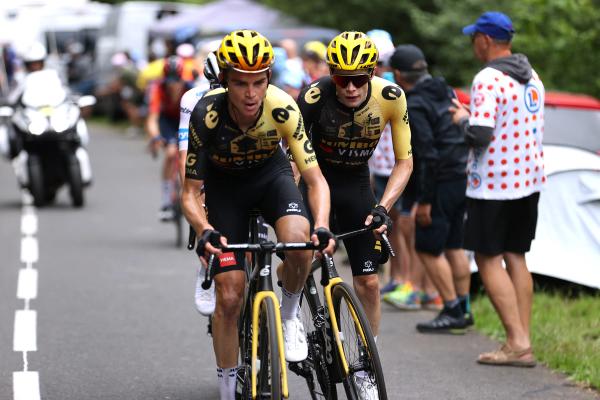Tour de France: reintroducing the Puy de Dôme
The details of the Tour’s dormant volcano that is set to explode into life on Sunday
Logan Jones-Wilkins
Junior Writer - North America
Photo by reservoircom from Adobe Stock
The Tour de France does not like to neglect its giants.
Whether that be its champions, or the climbs that elevated certain riders to their legendary status, the Tour knows its history and demands those who follow the sport know it as well. La Alpe d'Huez, Mont Ventoux, the Col du Tourmalet and the Galibier live on in the minds of cycling fans, regardless of age. They are institutions in and of themselves, sub-brands to the Tour. And, most importantly, they never seem to go out of fashion as the race organisation cycles them in within the rhythm that makes the Tour de France a comfortable summer spectacle.
For generations of riders, the Puy de Dome was one of these central sub-brands of the Tour. The winding road up the volcanic cone in the centre of France made for the perfect stadium to colour the Tour’s history books with the legacy defining battles between cycling's greats. Anquetil, Poulidor, Merckx, Hinault, Lemond – all had run-ins with the Puy de Dome that rivalled their rides on the Alpe or the Tourmalet.
And then the battles stopped. The Puy de Dome lay dormant as the 1980s came to a close. Its winding roads remained untouched throughout the reigns of Miguel Indurain and Lance Armstrong. The team Sky train never had to face the short explosive final that the Puy de Dome produces. The last time the climb was included in the Tour, gears changed by levers on a downtube. Now, gears are changed by a technology that would be adjacent to magic if seen by 1988 eyes.
So, with this understanding, what is the Puy de Dôme? Why is the climb so well-loved even after such a long absence? And, more importantly for this year’s Tour, how will the Puy de Dôme shape the 2023 Tour de France?
Profile: Spiralling up the volcano

The Puy de Dôme is distinct from the larger Col’s of the Alps and the Pyrenees because of its size, or more specifically lack thereof. It is much shorter, with the summit only stretching to 1400 metres. Furthermore, the basic stats of the climb belie the brutish difficulty of the Puy de Dôme.
From the city of Clermont-Ferrand, the race will climb for 13.5km at an average gradient of 7.6%. A hard climb, but a climb that doesn't quite measure up to the other great climbs of the Tour. The Puy de Dôme is less steep than the Alpe d’Huez, weighing in at 13.8km and 8.1%, shorter than the Tourmalet, coming in at 18.8km and 7.7%, and lower, shorter and shallower than Mont Ventoux – 20.8km, 7.7% and 1909 metres high.
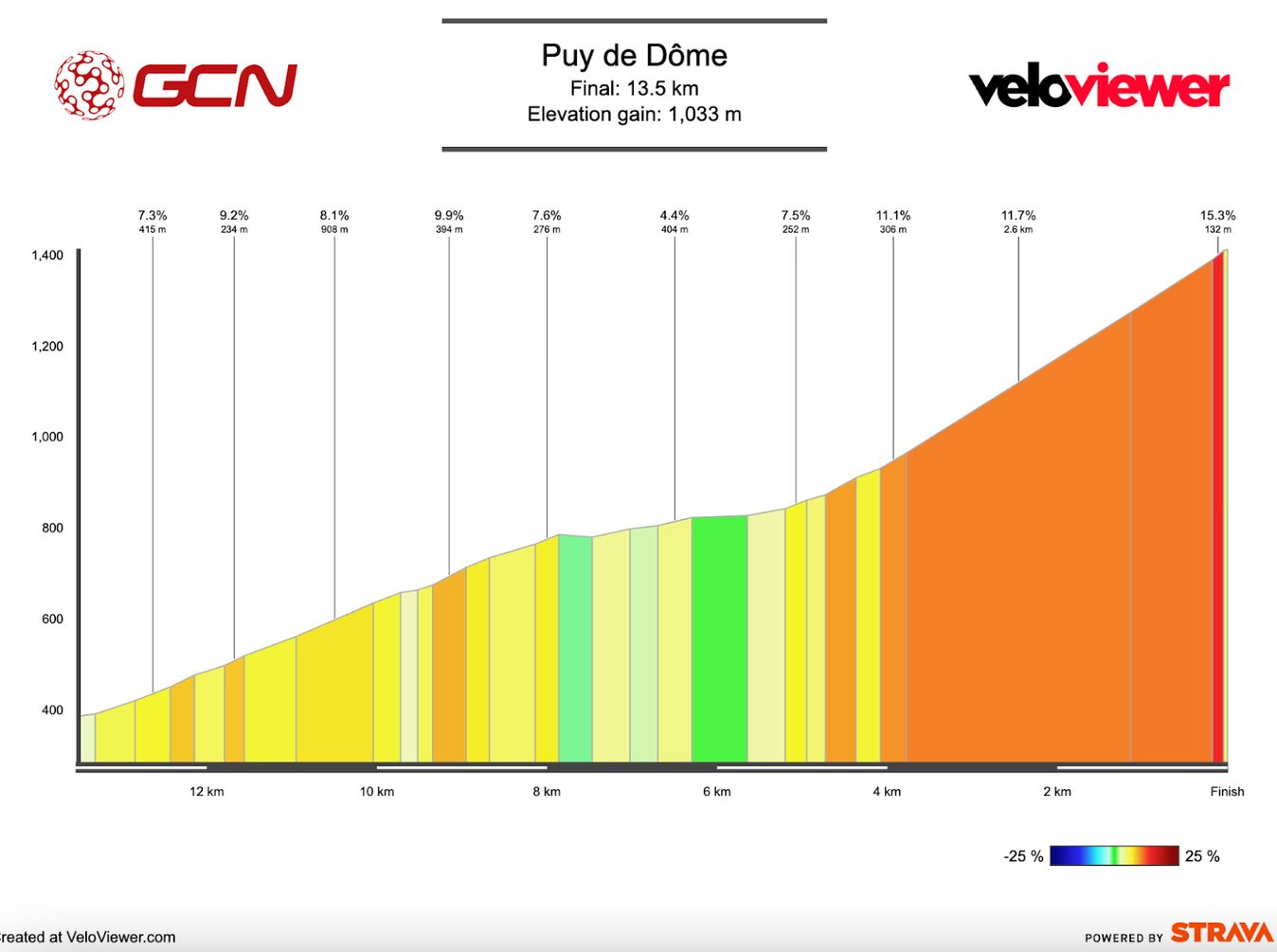
None of those climbs, however, have the sting of the Puy de Dôme. That is what makes the climb exceptional in the rolodex of climbs available to the Tour.
After the preamble through the suburbs of Clermont-Ferrand, the climb turns onto the narrow entryway to the upper slopes of the climb. With 4km to go, the climb starts in earnest with the double digit gradients awaiting the riders. The road runs parallel to a tram track as it starts the spiral around the volcanic cone and the 11-12% gradients do not stop for the remainder of the climb. It is consistent, steep, narrow, exposed and infernal. Like the Veloviewer profile, the climb will have the riders fighting for victory seeing red.

In total, the 4 kilometre section measures at around 12% average, meaning the climbing time for the fastest riders should be in the ballpark of 14 minutes, which would be in line with the climbing performances thus far at the Tour. Currently, the Strava segment is held by Romain Bardet who rode the climb on June 26 and had a time of 15:27 at a VAM of 1,815. For reference, Pogačar had a VAM (which is the metric used to calculate climbing speed) of 2090 up the steepest section of the final climb on stage 6.

Historically, climbs in the 10 to 15 minute range favour Pogačar over Vingegaard. Nevertheless, as we saw on stage 5, Vingegaard is more than capable at putting in a performance of those medium length steeper climbs.
History: the volcano that cemented a rivalry
In the history of the Puy de Dôme, the history that has made the return to the climb so delectable to cycling fans, is largely defined by two separate stages where the images and lore of what happened on the climb defined different periods in cycling. While the second point of history lives in infamy, especially for those in Belgium, the first was from the annals of the Tour de France of the 1960s and the French rivalry that ignited the nation: Jacques Anquetil versus Raymond Poulidor at the 1964 Tour de France.
With the 2023 Tour de France poised to be the next chapter of a budding great cycling rivalry, looking back on how the Puy de Dôme has handled head to head battles shows the potential importance Sunday might have.
Jacques Anquetil had been the king of the early sixties. With his power in the time trials, as one of the first true time trial specialists, Antequil made a habit of bludgeoning his spindly climbing competition in the long individual tests of the mid-century Tours. Antequil would then, like so many of the best GC riders since, ride efficiently and defensively in the mountains. That recipe gave Antequil unprecedented success at the Tour de France, with wins coming in 1957, 1961, 1962 and 1963 before the 1964 Tour. These were the days before Eddy Merckx and Bernard Hinault and the dominance of the Tour champions of before had never reached four victories.
That dominance, however, was not widely lauded in Anquetil’s home country. By the 1964 Tour, the French public, always a fickle fan base, instead had started to adopt Raymond Poulidor who seemed to be the next French hope and an appropriate antidote to Anquetil. In 1964 in particular, Poulidor was also much closer to Antequil than other riders had managed in the previous number of years, where his closest Tour contest was in 1963 where his next nearest competitor was 3:35 seconds behind.
All of this was weighing on the minds of cycling fans as the race reached central France after 19 stages of battles between the two Frenchman over the big climbs of the Pyrenees and the Alps. The Puy de Dôme, outside of the final 27 km time trial into Paris, would be Poulidor’s last chance to break the champion and reclaim the 56 seconds that he trailed Anquetil.
On the final four kilometres of the Tour, the showdown that followed is one that has vividly lived on since. Metre by metre, winding their way around the volcano, Anquetil stayed fixed to the side of Poulidor. Not behind him, not in front. Exactly next to him, matching his laboured pedal stroke for laboured pedal stroke, as the fans jeered at Anquetil and showered Poulidor with praise and cool water. Eventually, with 1km to the top, Poulidor finally pulled away. For the first time in his four year reign, Anquetil’s win was in doubt at the most dramatic moment.
In the end, Poulidor managed to claw back 42 seconds on the beleaguered Anquetil, but needed 14 more to claim the jersey. While there was the time trial to come, the gap was promising yet simultaneously insufficient. Famously, as reported in Paul Howard’s biography of the complicated French champion called Sex, Lies and Handlebar Tape, when Anquetil heard his gap after the finish, he couldn’t help but contain his confidence: “14 seconds? That is 13 more than I need.”
While the Tour de France has summited the Puy de Dôme 12 other times, including the climb where Eddy Merckx was punched in the yellow jersey as he was going for his sixth Tour victory in 1976 – a fascinating story, but one for another day – 1964 stands out in the context of modern cycling because it was such a precursor to the dynamics in cycling that followed.
The 1964 Tour ended up being the closest final GC gap up until that point at 56 seconds. After that Tour, the Tour was decided by less than a minute four times in the next 25 years. With the Tour previously having large gaps, showdowns between the climber types and time trial types were not as prominent or dramatic. Since then it is fundamental to the way cycling is raced.All of those elements, in particular, seem present today in the 2023 Tour de France, which makes stage 9 all the more mouth watering for cycling fans.
Preview: Pogačar versus Vingegaard set to erupt

© Velo Collection (TDW)/Getty Images
While Jonas Vingegaard and Tadej Pogačar might not have too many parallels to the Poulidor and Anquetil rivalry sixty years ago, the Puy de Dôme is still a perfect platform for the next round of their 2023 title fight. With the Pyrenees as a measuring stick to reference, the table is set for Pogačar to try to take time on a climb that perfectly suits his strengths, while Vingegaard will have his shortcomings on stage 6 fresh in his mind and be the defensive rider.
With a rest day coming on Monday, everything is in order for an all out duel in the final four kilometres. That seems all but certain. What is not certain is if the two will be fighting for the stage win and that dynamic will be the key tactical machinations from the stage.
To put it simply, Jumbo-Visma does not want the stage win to be up for grabs for the peloton, while UAE Team Emirates will be hoping for the time bonuses to be available at the finish because Pogačar will back himself to beat his Danish rival, even if it is down to a sprint. Furthermore, with the rest day to come, the cost of riding on the front of the peloton to keep a motivated break in check over the rolling terrain of the Massif Central will not be as important. Once again, it could be a big day for Mikkel Bjerg, Vegard Staken Laegen and Matteo Trentin, with hopefully a better pay-off than the stage 5 flop.

Jumbo-Visma, on the other hand, will be hoping a breakaway is up the road with a healthy advantage. While they will, as always, keep numbers around Jonas Vingegaard, it would not be altogether surprising to see some of the Jumbo-Visma men in the breakaway since they still have their full complement of riders. It could be Teisj Benoot, it could be Dylan van Baarl, it could be Wilco Kelderman, and, of course, it could be Wout van Aert. But it could also be no one. Jumbo-Visma still has lots of different potential plays.
The rider who will not be in any breakaways, or not yet at least, is Sepp Kuss. Kuss was used to launch Vingegaard on the Tourmalet, but crucially was unable to assist his leader after the initial failed attack. With Kuss showing that he is the only rider that can come close to Vingegaard and Pogačar when the pace gets very fast on very steep roads, it is essential that Vingegaard keeps the American around to help match Pogačar’s inevitable attacks. Kuss is too capable in climbs over 10% to ignore and might be the key to Vingegaard’s defence. Plus, keeping Kuss at his current GC time deficit will keep the outside chance that he could be used in a breakaway to put pressure on UAE in the event that the yellow jersey changes hands.
Regardless of what happens, it seems impossible that stage 9 will flame out into a GC stalemate. Both teams and both riders will be motivated and encouraged at the opportunity afforded by the Puy de Dôme. Put history aside and this stage is still poised to be a cracking stage. With the context of the history and the long drought without the Tour visiting this particular climb, the stage seems like it could be an all time moment. In the end, history will decide that distinction, but for now it is crucial to understand the moment we could be living in.
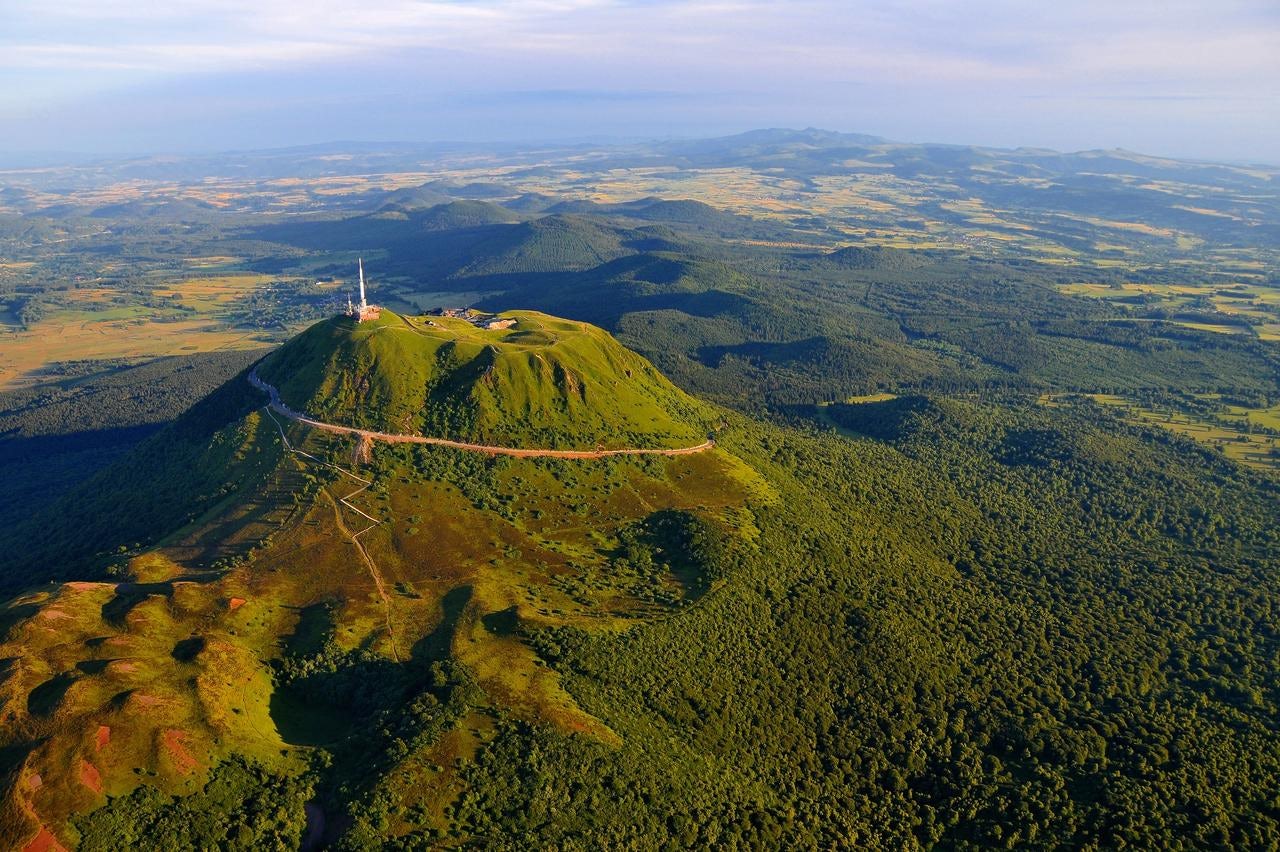
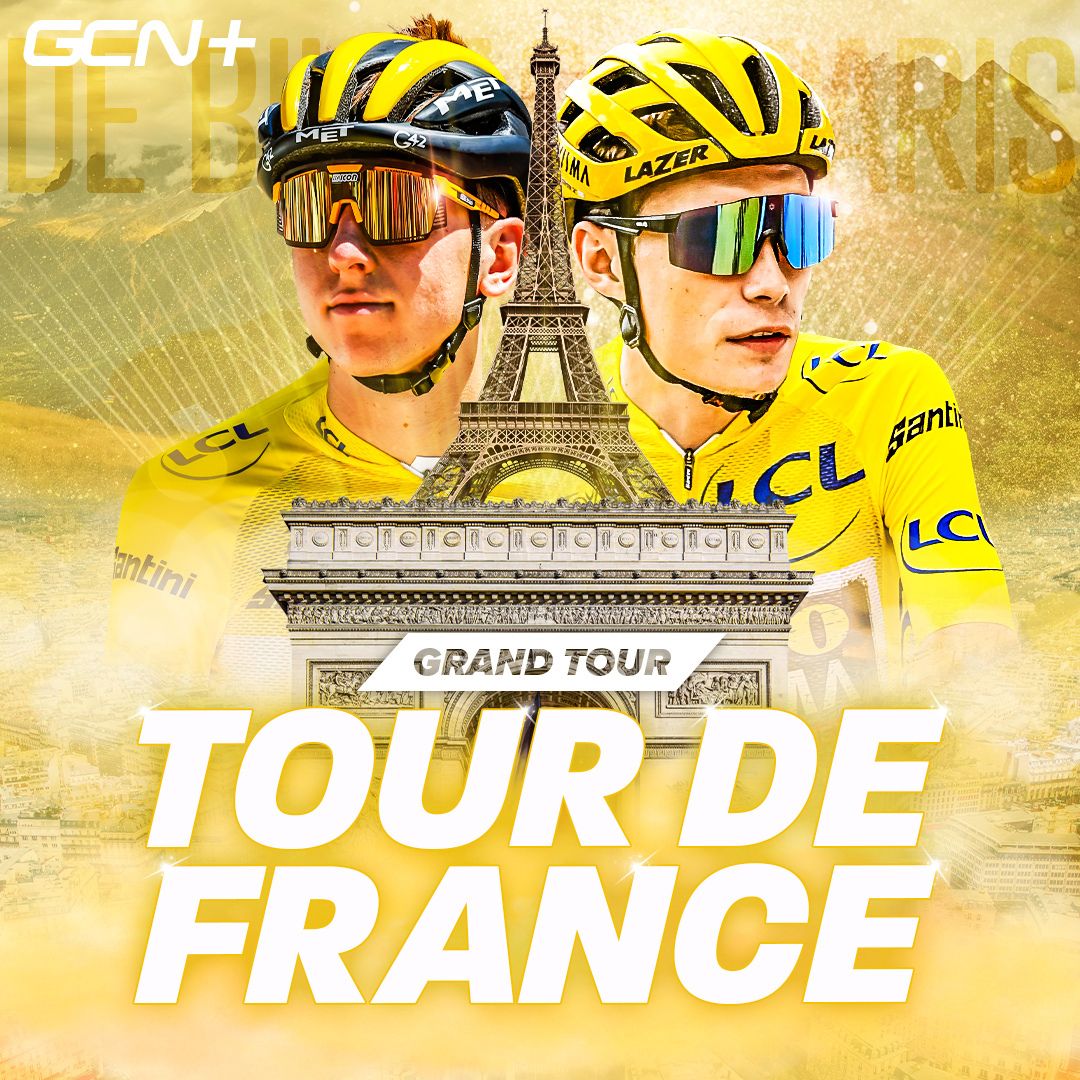MAIN.jpg?w=600&auto=format)






![Romain Bardet: ‘The climb is so hard that I’m sure in [next series of Tour de France: Unchained], we will have some shots of the iconic climb!’](https://cdn.sanity.io/images/hk2y3slq/production/2ffd7c9dd3e3c3b751b3a2590223ed5211964f4b-5568x3712.jpg/GettyImages-1408453401.jpg?w=600&auto=format)
